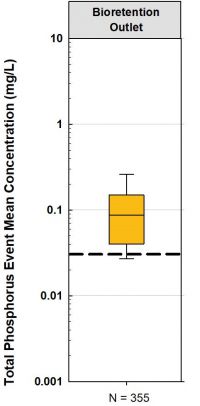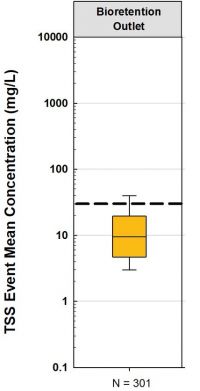Bioretention: Performances
Phosphorus Reduction[edit]
The performance results for Bioretention practices, located within TRCA's watershed originate from three primary sites:
- Kortright Centre
- Earth Rangers
- Seneca College
- Aurora Community Centre
- Central Parkway (Mississauga)
- Wychwood Subdivision (Brampton)
- IMAX Corporation, head office
The mean performance value recorded at the outlet for Bioretention practices' ability to remove Total Phosphorus (TP) was calculated based on 355 separate recordings between 2005-2007, 2011-2019 and 2021 amongst the six sites previously mentioned.
As can be seen in the corresponding boxplot the mean performance removal efficiency of the bioretention practices monitored are not meeting the acceptable upper extent range of nutrients as of 0.03 mg/L (30 µg/L) (Environment Canada, 2004[1]; [2]).
The median value of the 355 samples taken was 0.87 mg/L whereas the mean was 0.123 mg/L, with an 86% guideline exceedance. Given the age of most of these practices, more inspection, maintenance and necessary rehabilitation will be needed to ensure they are able to meet the federal and provincial governments' guideline requirement for stormwater quality.
TSS Reduction[edit]
The performance results for Bioretention practices, located within TRCA's watershed originate from three primary sites:
- Kortright Centre
- Earth Rangers
- Seneca College
- Central Parkway (Mississauga)
- Wychwood Subdivision (Brampton)
- IMAX Corporation, head office
The mean performance value recorded at the outlet for Bioretention practices' ability to remove Total Suspended Sediments (TSS) was was calculated based on 301 separate recordings between 2005-2007, 2011-2019 and 2021 amongst the six sites previously mentioned.
As can be seen in the corresponding boxplot the mean performance removal efficiency of the bioretention practices monitored are well below the suggested guideline of 30 mg/L (Canadian Water Quality Guideline (CWQG), </ref>).
The median value of the 355 samples taken was 0.87 mg/L whereas the mean was 0.123 mg/L, with an 86% guideline exceedance. Given the age of most of these practices, more inspection, maintenance and necessary rehabilitation will be needed to ensure they are able to meet the federal government's guideline requirement for stormwater quality.
https://sustainabletechnologies.ca/app/uploads/2015/06/SynthesisWaterQuality_Statistics_May2015.pdf
References[edit]
- ↑ Environment Canada. (2004). Canadian guidance framework for the management of phosphorus in freshwater systems. Ecosystem Health: Science‐based solutions report no. 1–8. Cat. No. En1–34/8–2004E.
- ↑ Ontario Ministry of Environment and Energy (OMOEE). 1994. Policies, Guidelines and Provincial Water Quality Objectives of the Ministry of Environment and Energy. Queen’s Printer for Ontario. Toronto, ON.

